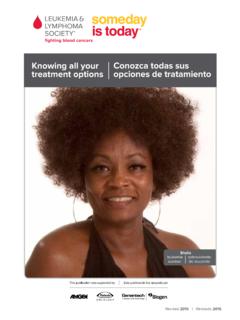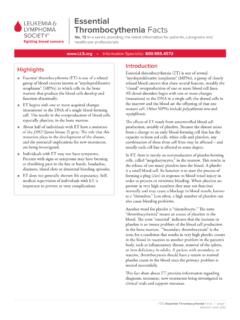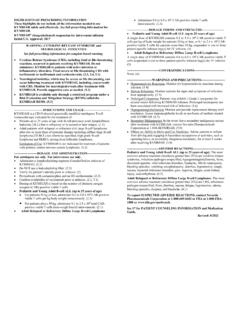Transcription of Cord Blood Stem Cell Transplantation
1 leukemia LYMPHOMA MYELOMA. FACTS. Cord Blood Stem Cell Transplantation No. 2 in a series providing the latest information on Blood cancers Highlights Umbilical cord Blood , like bone marrow and peripheral Blood , is a rich source of stem cells for Transplantation . There may be advantages for certain patients to have cord Blood stem cell transplants instead of transplants with marrow or peripheral Blood stem cells (PBSCs). Stem cell transplants (peripheral Blood , marrow or cord Blood ) may use the patient's own stem cells (called autologous transplants ) or use donor stem cells. Donor cells may come from either a related or unrelated matched donor (called an allogeneic transplant ). Most transplant physicians would not want to use a baby's own cord Blood ( autologous transplant ) to treat his or her leukemia .
2 This is because donor stem cells might better fight the leukemia than the child's own stem cells. Cord Blood for Transplantation is collected from the umbilical cord and placenta after a baby is delivered. Donated cord Blood that meets requirements is frozen and stored at a cord Blood bank for future use. The American Academy of Pediatrics's (AAP) policy statement (Pediatrics; 2007;119:165-170.). addresses public and private banking options available to parents. Among several recommendations, the report encourages parents to donate to public cord Blood banks and discourages parents from using private cord Blood banks for personal or family cord Blood storage unless they have an older child with a condition that could benefit from Transplantation .
3 The Stem Cell Therapeutic and Research Act of 2005 put several programs in place, including creation of the National Cord Blood Inventory (NCBI) for patients in need of Transplantation . Research studies of cord Blood transplant outcomes, including transplants with two or more cord Blood units, show promising results. Stem Cell Transplantation The Transplantation of Blood -forming stem cells is an accepted treatment to restore the body's ability to make Blood and immune cells. Blood -forming or hematopoietic stem cells (HSCs) can develop into any of the three types of Blood cells: red cells, white cells or platelets. Published as a public service by The leukemia & Lymphoma Society 1311 Mamaroneck Avenue White Plains, NY 10605.
4 Information Resource Center (IRC) IRC Cord Blood /2. Cancer treatment with very high-dose chemotherapy or radiation therapy may result in severe injury to Blood -forming cells in marrow, the spongy material inside the center of bones. Certain patients with leukemia , lymphoma, myeloma, myelodysplastic syndromes (MDS) or other Blood cancers may benefit from high-dose chemotherapy or radiation therapy followed by stem cell Transplantation . Patients with some other inherited or acquired marrow or immune system disorders may also benefit from stem cell Transplantation . Sources of Stem Cells for Transplantation The cells used in transplants can come from three sources: marrow, peripheral Blood and the Blood in the umbilical cord after a baby's birth.
5 To obtain cells from marrow, the physician removes marrow from a donor's hip bone in a surgical procedure using anesthesia, sterile needles and syringes. The donor's body replaces the donated bone marrow in four to six weeks. Currently, peripheral Blood is the most common source of stem cells for transplant. Peripheral Blood stem cells (PBSCs) are Blood -forming stem cells released from the marrow into the bloodstream. Peripheral Blood is also called circulating Blood . Normally, the marrow releases only a small number of these stem cells into the Blood . To obtain enough stem cells from the peripheral Blood for a transplant, a donor is given medication that encourages more Blood -forming stem cells to move from the marrow to the Blood .
6 The cells are collected from the Blood using a process called apheresis. For apheresis, a needle is placed in the donor's vein, usually in the arm. The donor's Blood passes through a machine that removes the stem cells and then returns the rest of the Blood to the donor. The donor's body replaces the cells in two to three weeks. Cord Blood stem cells are collected from the umbilical cord and placenta after a baby is born. Cord and placental Blood contain large numbers of Blood -forming stem cells. The donated cord Blood is screened, frozen and stored at a cord Blood bank for future use if it meets screening requirements. The stored cord Blood collected from the umbilical cord and placenta after a baby is born is called a cord Blood unit.
7 Cord Blood Stem Cell Transplants The first successful cord Blood stem cell transplant was performed in 1988 in Paris, France. The patient was a boy with Fanconi anemia, a genetic and potentially life-threatening type of anemia. Cord Blood stem cell transplants have now been given successfully to patients (mostly children) with some 70 diseases, including acute lymphocytic leukemia (also called acute lymphoblastic leukemia , or ALL), acute myelogenous leukemia (AML), myelodysplastic syndromes (MDS), chronic myelogenous leukemia (CML), juvenile chronic myelogenous leukemia (JCML), chronic lymphocytic leukemia (CLL), Hodgkin and non- Hodgkin lymphoma, neuroblastoma, thalassemia, severe combined immune deficiency (SCID), Wiskott- Aldrich syndrome, metabolic diseases such as adrenoleukodystrophy and Hurler syndrome, and severe aplastic anemia.
8 To date, more than 5,500 cord Blood stem cell transplants from unrelated donors and several hundred from sibling donors have been performed worldwide. Published as a public service by The leukemia & Lymphoma Society 1311 Mamaroneck Avenue White Plains, NY 10605. Information Resource Center (IRC) IRC Cord Blood /3. Cord Blood transplants can have complications similar to allogeneic stem cell transplants and should be done only at centers experienced in the Transplantation of allogeneic sources of stem cells. Potential Advantages for Patients For certain patients, there may be advantages to using donor cord Blood stem cells instead of donor peripheral Blood or donor marrow stem cells. Some potential advantages are Availability.
9 Cord Blood stored in a public cord Blood bank has been prescreened, tested and frozen and is ready to use; on the other hand, it can take several months to find and confirm a marrow or peripheral Blood donor. Human Leukocyte Antigen (HLA) Matching. The outcomes of related and unrelated donor stem cell transplants are strongly affected by the degree of HLA matching between the transplant recipient and the donor cord Blood . HLA matching plays an important role in successful engraftment, severity of graft - versus -host disease (GVHD) and overall survival. A close match between the patient and the cord Blood unit can improve a patient's outcome after Transplantation . However, even though a closely matched cord Blood unit is preferred, clinical studies suggest that the match may not have to be as close as the match that is necessary for bone marrow or peripheral Blood transplants.
10 graft - versus -Host Disease. Studies have found that after a cord Blood stem cell transplant, fewer patients got GVHD and, among those patients who did develop GVHD, the complication tended to be less severe than it was in patients who had bone marrow or peripheral Blood transplants. GVHD is a serious and sometimes fatal complication of allogeneic stem cell Transplantation . With GVHD, the donor's immune cells (the graft ) attack the patient's healthy tissue (the host). Diversity. As a result of extending collection efforts to hospitals where births from diverse ethnic backgrounds are well represented, donated cord Blood units have the potential to provide a source of stem cells that reflects racial diversity. Infectious Disease Transmission.













